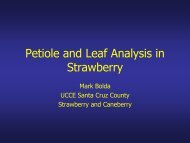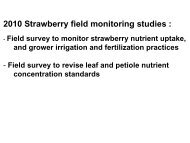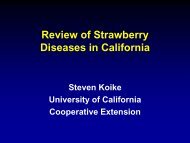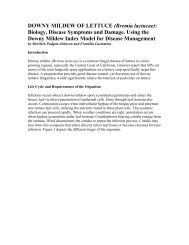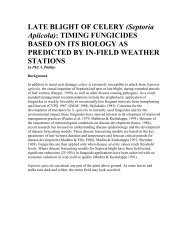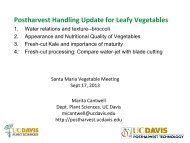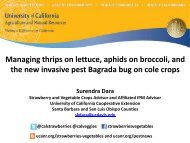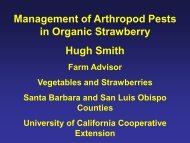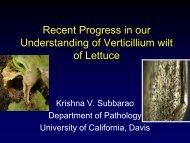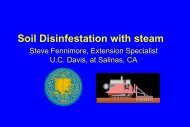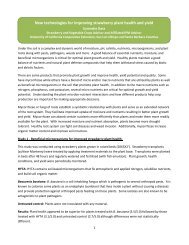Diagnosing Strawberry Root and Crown Diseases - Santa Barbara ...
Diagnosing Strawberry Root and Crown Diseases - Santa Barbara ...
Diagnosing Strawberry Root and Crown Diseases - Santa Barbara ...
You also want an ePaper? Increase the reach of your titles
YUMPU automatically turns print PDFs into web optimized ePapers that Google loves.
<strong>Diagnosing</strong> <strong>Strawberry</strong> <strong>Root</strong> <strong>and</strong><br />
<strong>Crown</strong> <strong>Diseases</strong><br />
? ?<br />
Heather Scheck, Plant Pathologist, <strong>Santa</strong> <strong>Barbara</strong> County Ag Commissioner’s Office
Soil Borne Pathogens<br />
• Symptoms are not diagnostic – not even to separate<br />
biotic from abiotic<br />
• There is no one single method for isolating or<br />
identifying all root or crown pathogens<br />
• All cause “browning”, streaking <strong>and</strong> decay<br />
• Field guides offer only clues: more red- than brown,<br />
more orange- than red, buff-colored, tan-colored,<br />
reddish- colored, rust-colored, cinnamon-red or<br />
chocolate- brown, brown- but not black ??
Soil Borne Pathogens<br />
• Microscopy alone not usually an option<br />
• For regulatory purposes, identification needs<br />
to be at least to species, often to a subspecies<br />
or variety level (highly accurate)<br />
• Without selective isolation techniques,<br />
pathogens cannot be detected or confirmed<br />
• Saprophytic competitors <strong>and</strong> secondary<br />
pathogens quickly invade diseased tissues<br />
making diagnosis impossible
Soil Borne Pathogens- Culturing<br />
• Diagnosis depends on the quality of the sample<br />
• Always want the whole plant – not completely dead<br />
• Include rhizosphere soil only for certain tests –<br />
sclerotial counts, nematodes
Soil Borne Pathogens- Culturing<br />
• Non-selective media – generally supportive to bacterial <strong>and</strong><br />
fungal growth, favors saprophytes (soil is dirty)<br />
• Semi-selective or selective media adds anti-bacterials or antifungals,<br />
surfactants, amino acids, or sugars - available for<br />
some pathogens not all, value is variable<br />
Non-selective medium
Soil Borne Pathogens- Culturing<br />
• Look at colony shape, size,<br />
color <strong>and</strong> texture<br />
• Variable depending on the<br />
growth medium used, age of<br />
colony, growth conditions<br />
(light spectrum <strong>and</strong> day<br />
length, temperature)
Soil Borne Pathogens- Culturing<br />
• use microscopy to look at spore sizes, shapes, colors, <strong>and</strong> the<br />
structures that produce spores
Soil Borne Pathogens – other methods<br />
• ELISA: Enzyme-linked Immunosorbent Assay<br />
• No need to culture <strong>and</strong> gives very rapid results<br />
• Very sensitive to low pathogen density<br />
• Doesn’t require the pathogen to be alive (+/-)<br />
Plate is coated with a capture antibody; (2) sample is added, <strong>and</strong> any<br />
antigen present binds to capture antibody; (3) detecting antibody is<br />
added, <strong>and</strong> binds to antigen; (4) enzyme-linked secondary antibody is<br />
added, <strong>and</strong> binds to detecting antibody; (5) substrate is added, <strong>and</strong> is<br />
converted by enzyme to detectable form (color change)
Soil Borne Pathogens – other methods<br />
• ELISA: Enzyme-linked Immunosorbent Assay<br />
• Quick tests for some select pathogens (mostly viruses)<br />
• Can be used in the field – give rapid results but maybe only to<br />
genus (Phytophthora), sometimes to species (X. fragariae)
Soil Borne Pathogens- Molecular methods<br />
• Nucleotide sequencing – most accurate method<br />
• ITS -internal transcribed spacer- non-functional RNA<br />
sequence. Widely used because it is easy to amplify even<br />
from small quantities <strong>and</strong> has a high degree of variation even<br />
between closely related species.
Most Common <strong>Strawberry</strong><br />
<strong>Root</strong> <strong>and</strong> <strong>Crown</strong> Pathogens<br />
• Anthracnose – Colletotricum acutatum<br />
• Black <strong>Root</strong> Rot –Cylindrocarpon spp.<br />
• Fusarium Wilt – Fusarium oxysporum<br />
• Charcoal Rot –Macrophomina phaseolina<br />
• Phytophthora –several species<br />
• Verticillium Wilt – Verticillium dahliae<br />
• Nematodes – several species
Anthracnose <strong>Crown</strong> <strong>and</strong> <strong>Root</strong> Rot<br />
• Little is known about how it survives in the soil<br />
• Grows also on decaying tissue <strong>and</strong> plants could be<br />
exposed during normal practices of digging, trimming<br />
<strong>and</strong> packing<br />
• Cinnamon – to – red discoloration of the crown
Anthracnose <strong>Crown</strong> <strong>and</strong> <strong>Root</strong> Rot<br />
• Ascomycte fungus Colletotrichum acutatum<br />
• When above ground structures infected, you see the signs of<br />
the pathogen as spore masses (rarely seen below ground)<br />
• Produces spores in an acervulus<br />
• Primarily a fruit rotter, also infects stolons <strong>and</strong> petioles
Anthracnose <strong>Crown</strong> <strong>and</strong> <strong>Root</strong> Rot<br />
• Isolate from the margin of healthy <strong>and</strong> discolored tissue<br />
• Grows on semi-selective media for fungi amended with<br />
antibacterial <strong>and</strong> antifungal compounds<br />
• Identification based on colony size <strong>and</strong> shape plus on size <strong>and</strong><br />
shape of conidia
Cylindrocarpon Black <strong>Root</strong> Rot<br />
• Cosmopolitan pathogen with a large host range<br />
• Isolated on semi-selective media<br />
• Species difficult to separate on characters – <strong>and</strong><br />
under taxonomic review<br />
C. destructans C. liriodendri<br />
C. macrodidymum
Cylindrocarpon Black <strong>Root</strong> Rot<br />
Most have predominately microconidia<br />
(<strong>and</strong> a few 2-3 celled macroconidia)<br />
Most make large numbers of thickwalled<br />
chlamydospores in chains or<br />
clusters
Fusarium oxysporum<br />
• Easy to isolate on semi-selective media<br />
• Easy to speciate to Fusarium oxysporum<br />
• Many non-pathogenic strains commonly found<br />
in field soils – need Pathogenicity test or known<br />
DNA sequences from <strong>Strawberry</strong> to confirm
Fusarium oxysporum<br />
• Identification can be based on the size <strong>and</strong> shape of<br />
multiple types of spores, but microscopy cannot give proof<br />
of pathogenicity – diagnose with that disclaimer<br />
• Needs ITS test protocol or greenhouse tests<br />
Macroconidia Microconidia Chlamydospores
Charcoal Rot - Macrophomina phaseolina<br />
• Cutting the crowns of affected plants reveals reddishbrown<br />
necrotic areas on the margins<br />
• May find sclerotia, but could be many other 2 o fungi<br />
Discolored crowns<br />
Sclerotia in tissues
Charcoal Rot - Macrophomina phaseolina<br />
• Symptoms are similar to those caused by other<br />
crown-rot pathogens such as Colletotrichum <strong>and</strong><br />
Phytophthora species.<br />
• Plants initially show signs of water stress <strong>and</strong><br />
subsequently collapse<br />
• To confirm a diagnosis, the<br />
pathogen must be isolated<br />
in culture from the diseased<br />
crowns
Phytophthora <strong>Crown</strong> <strong>and</strong> <strong>Root</strong> Rot<br />
• Phytophthora cactorum, P. citricola, P. parasitica, P.<br />
megasperma <strong>and</strong> P. fragariae*<br />
• brown discoloration in the crown, with or without a<br />
brown-to-black root rot.
Phytophthora <strong>Crown</strong> <strong>and</strong> <strong>Root</strong> Rot<br />
• ELISA gets you easily to Phytophthora spp.<br />
• CDFA regulates P. fragariae in Nursery Code – nurseries must<br />
be free-from Red Stele<br />
• Very difficult to isolate Phytophthora from mushy rotted tissues<br />
• Working on PCR test for P. fragariae but needs to be reviewed<br />
<strong>and</strong> accepted by stakeholders
Verticillium Wilt<br />
• Verticillium dahliae non host-specific <strong>and</strong> infects<br />
many weed species <strong>and</strong> crops<br />
• Symptoms also nonspecific with stunting, wilting <strong>and</strong><br />
browning of leaves <strong>and</strong> crowns
Verticillium Wilt<br />
• Pathogen produces conidia <strong>and</strong> grows inside the<br />
vascular system<br />
• Produces microsclerotia that go back into the soil<br />
<strong>and</strong> are long lasting
Testing soil pre-plant for Verticillium<br />
• dilution plating method on a selective media<br />
(Sorenson's NPX) finds levels of Verticillium<br />
propagules per gram of soil (VPPG).<br />
• <strong>Strawberry</strong> can only tolerate low numbers of VPPG
<strong>Strawberry</strong> Nematodes:<br />
Soil-borne endo- <strong>and</strong> ecto- parasites<br />
<strong>Root</strong> Lesion<br />
(Pratylenchus penetrans)<br />
Stem<br />
(Ditylenchus dipsaci)<br />
Dagger<br />
(Xiphinema americanum)<br />
Needle<br />
(Longidorus elongatus)<br />
<strong>Root</strong> knot<br />
(Meloidogyne incognita,<br />
M. javanica, M. hapla*)
<strong>Strawberry</strong> Nematodes:<br />
Soil-borne endo- <strong>and</strong> ecto- parasites<br />
•Field symptoms not diagnostic – stunting, poor<br />
growth, low yield<br />
•Detection relatively easy<br />
•Quantifying affect much more difficult
Summary- <strong>Strawberry</strong> <strong>Crown</strong> <strong>and</strong> <strong>Root</strong><br />
<strong>Diseases</strong><br />
• Symptoms are not diagnostic – no accurate<br />
field ID for any of them<br />
• Diagnosis by different methods depending on<br />
pathogen – no one test<br />
• Improvements always needed, especially for<br />
regulatory work<br />
• OK to ask questions about how<br />
the diagnosis was made



